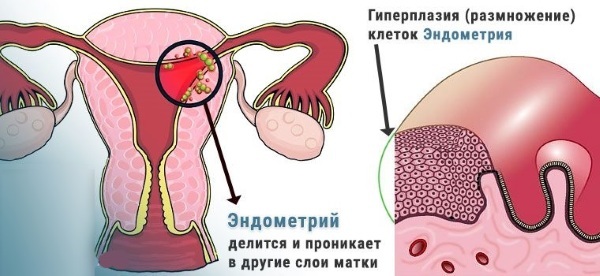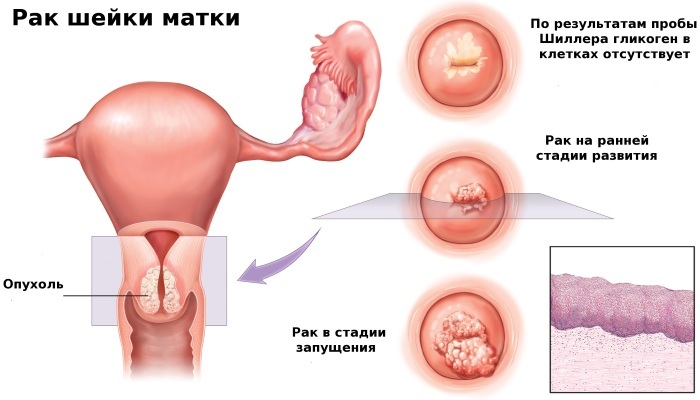Endometrial hyperplastic process (GGE) in gynecology occupies one of the leading places. This is a pathology that includes several diseases at once, similar in etiological characteristics. It is characterized by focal or diffuse proliferation (thickening) of the stromal and glandular structures of the uterus.
The peculiarity of GGE is the rapid multiplication and changes in the structure of endometrial cells. In this case, the disease is benign, but without adequate treatment, there is a risk of developing cancer. The disease can manifest itself in women of any age, but with age (closer to the menopause), the risk of pathology increases.
That is why disease prevention plays an important role. A regular visit to a gynecologist allows you to identify the problem in the early stages and prevent it from degenerating into a malignant lesion.
Record content:
- 1 Views
- 2 Stages and degrees
- 3 Symptoms
- 4 Reasons for the appearance
- 5 Diagnostics
- 6 When to see a doctor
- 7 Prophylaxis
-
8 Treatment methods
- 8.1 Medications
- 8.2 Traditional methods
- 8.3 Other methods
- 9 Possible complications
- 10 Video about GGE
Views
GGE in gynecology is an oncological disease, but refers to a benign formation, in which the inner layer of the uterus (endometrium) is affected. It is characterized by the proliferation of the inner mucous layer, as a result of which its cells rapidly divide and change their structure. This process will certainly lead to an increase in the female genital organ.
According to disappointing medical statistics, 70% of women with a similar problem acquire uterine cancer over time. Given these huge numbers, doctors strongly recommend that you regularly visit a gynecologist and begin treatment immediately after the first alarming symptoms appear.
Types of endometrial hyperplastic processes:
| Views | Description |
| Glandular hyperplasia | It is characterized by the proliferation and non-standard localization of the glandular structures of the uterus, while their secretory functionality is not disturbed. A distinctive feature of this form is the fusion of two layers of the endometrium (functional and basal). With the onset of the damaging process, the dividing line between them disappears. If the pathology is not treated, this form progresses rapidly and gives impetus to the development of the next type - cystic-glandular. |
| Cystic glandular hyperplasia | There is an overgrowth of the inner layer of the uterus, which is aggravated by cystic lesions. |
| Cystic hyperplasia | The condition has a more vivid clinical picture, and in gynecology it is defined as a precancerous condition. |
| Basal hyperplasia | A rather rare phenomenon, it is characterized by the multiplication of cells of the basal layer of the endometrium. |

There is another type of hyperplasia - this is polyp, in which connective tissue is damaged and polyps are formed. Polyps are benign growths. They have a different character of appearance, they can appear both in the singular and in the plural.
The neoplasms are an oval or rounded body, located on a pedicle, their size is insignificant. Often localized at the bottom of the uterus, but can form in the corners of the fallopian tubes. By themselves, polyps are already a neoplasm, which is dangerous because in 10% of cases it easily turns into a malignant form.
Stages and degrees
GGE in gynecology has two degrees of development, these are:
- diffuse - uniform proliferation of endometrial cell tissue;
- focal - there is a lesion of certain areas of the endometrium with varying intensity.
For better treatment and selection of tactics, GGE was conditionally divided into stages at which its own characteristic symptomatology and its intensity are noted. This technique makes it possible to identify how the process is running and life-threatening.
GGE stages:
- simple - a noticeable thickening of the glandular layer, in which the functionality and structure of the uterus is not disturbed;
- complex - heterogeneous growth of the glandular layer of the endometrium;
-
simple and complex with atypia - a noticeable increase in the glands, destruction of the cell structure is noted in the endometrium.

It is the last stage (difficult and simple with atypia) that gives high chances for the degeneration of pathology into a malignant process.
Symptoms
GGE in gynecology is a complex of pathological processes that are difficult to determine at the initial stage. Often, women find out about the presence of a problem only after the next examination by a gynecologist. The disease is complicated by the formation of polyps.
GGE can be ascertained by the main signs - these are menstrual irregularities and intrauterine bleeding, which usually occur between periods.
In addition to these symptoms, the disease may be accompanied by the following:
- failure of menstruation or their absence for one or several months;
- the unstable nature of menstruation and secretory secretions;
- discharge with impurities of blood between periods (often a similar phenomenon worries women after menopause);
- spotting before menstruation;
- a long course of critical days (7 days or more);
- with the progression of GGE, soreness occurs, the intensity of which increases during sexual intercourse;
- anemia;
- pallor of the skin;
- suppression of performance and vitality;
- dizziness;
- loss of appetite.
Reasons for the appearance
Two main factors lead to the development of GGE, each of which has its own characteristic course of pathology.
This is:
- Hormonal disorders. A change in the content of hormones in the blood provokes a change in the growth and differentiation of endometrial cells. This is due to the fact that the endometrium is a target for sex hormones. As a result, the physiological properties of the uterine mucosa are disrupted, the cells grow rapidly, and the thickness of the endometrium increases. Such pathological processes lead to hyperplasia.
-
Lack of dependence on hormonal disruptions. There is a problem with the reception of the tissues of the uterus. At the same time, the hormonal background is normal, however, the target organ is not susceptible to the effects of sex hormones.

The further development of the pathology depends on the form of GGE, the localization of the lesion and the individuality of the organism.
The prerequisites for the development of the disease can be:
- genetic predisposition;
- female infertility;
- regular disruptions of the menstrual cycle;
- a history of diabetes mellitus;
- excess weight;
- abortion;
- immunodeficiency virus;
- the presence of chronic inflammation localized in the uterus, ovaries or appendages;
- polycystic.
Often, several predisposing factors lead to the formation of pathological changes. Weakened immunity, poor ecology, somatic diseases - all this can also cause the appearance of GGE.
Diagnostics
Before prescribing treatment, the patient must undergo an examination by a gynecologist and carry out a number of diagnostic measures. With HPE, it is important to accurately differentiate the situation in order to avoid the transformation of pathology into a malignant course.
Basic diagnostics includes an ultrasound examination, which determines the thickness of the endometrium and the location of possibly formed polyps. However, it should be noted that this method is not very informative, since it is difficult to make an accurate diagnosis based on its results. But, nevertheless, the results of ultrasound make it possible to identify abnormalities in the endometrium of the uterus.
Having established the thickness of the endometrial layer by ultrasound, the gynecologist determines the need for further diagnostics. Layer thickness norm - no more than 5 mm.
Depending on the revealed thickness, an additional study is assigned:
- with a layer thickness of up to 7 mm, the patient is shown regular monitoring of the state of the uterus over the next six months;
- with a layer thickness of 8 to 10 mm, the patient is prescribed a diagnostic curettage, carried out for the purpose of therapy;
- with an endometrial thickness of more than 11 mm, doctors perform curettage of the uterine cavity and cervix.

To establish a more accurate picture of the disease, a number of procedures are prescribed:
- in the presence of diffuse organ damage, endometrial samples are taken for biopsy studies;
- hysteroscopic examination of the biomaterial is shown both for diffuse and focal lesions of the organ (the most informative method for identifying the prevalence of the pathological process);
- after carrying out diagnostic curettage, the material is taken for histological examination;
- to establish the quality of the patency of the fallopian tubes and the presence of polyps, echosalpingography is performed.
For postmenopausal patients, it is important to differentiate the presence of other pathologies that occur in conjunction with HPE.
This is:
- malignant cell damage;
- fibroid formation;
- hormone-producing neoplasms in the ovarian area.
Treatment of HPE depends on its form, it can be a conservative tactic, and in difficult situations - surgical treatment.
When to see a doctor
Often, women turn to doctors only if there are obvious symptoms. However, medical experts strongly recommend that you undergo a gynecologist's examination every six months. This will make it possible to stop the pathological process that has begun in a timely manner and begin its adequate treatment.
Alarming signs that should obligatory force a woman to see a doctor:
- bleeding;
- discharge with impurities of blood between periods;
- cramping pain in the lower abdomen;

- disruptions of the menstrual cycle;
- long periods (more than 7 days);
- deterioration in general health (weakness, malaise, dizziness);
- impossibility of conception.
Also, if the ultrasound results reveal any abnormalities in the thickness of the endometrial layer, additional diagnostics should be carried out immediately and treatment should be started.
Prophylaxis
GGE in gynecology is a series of pathological processes that, without timely treatment, threaten with malignancy. Therefore, the basis for the prevention of endometrial hyperplastic processes lies in the timely identification of the problem.
With the onset of menopause, women should take hormonal drugs that restore the balance of the hormones estrogen and progesterone. In this case, the doctor must definitely control the level of these substances. The estrogen concentration should not exceed the progesterone concentration.
The complex of preventive measures is as follows:
- regular check-ups by a gynecologist;
- excluding the likelihood of gaining too much weight;
- maintaining a healthy lifestyle (exclusion of all bad habits);
- balanced nutrition, rich in useful vitamins and minerals;
- timely therapy of diseases of the organs of the genitourinary system;
- competent selection of hormone-containing drugs.
It is also necessary to dwell on the issue of frequent abortions. A plurality of them gradually disrupts the integrity of the uterine tissues and leads to the proliferation of the endometrium. Therefore, the use of contraceptives is an integral part of the prevention of GGE.
Treatment methods
Treatment for HPE is based on the following principles:
- relief of uterine bleeding;
- normalization of the cycle in patients of reproductive age;
- relapse prevention.

For these purposes, it is recommended to do an ultrasound scan with a regularity of 2-3 times a year. With the same regularity, take a blood test for hormones.
Medications
GGE in gynecology is a problem that requires timely and comprehensive drug treatment. First of all, the goal of therapy is to correct menstrual irregularities, stop anovulations, and normalize homeostasis disorders.
Hormone therapy is used to restore a regular cycle. The choice of drugs and dosage is determined taking into account the degree of estrogen saturation and the results of functional diagnostics. In this case, the age of the patient and the state of reproductive function are taken into account.
Homeostasis disorders are treated only at the third stage of conservative therapy. This is approximately 3-6 months after starting the medication.
Stages of homeostasis disorders treatment:
| Events | Description |
| Restoration of fat metabolism in the body |
|
| Sedation therapy |
|
| Improving brain performance |
|

With the development of HPE during menopause, the goal of therapy is to eliminate the inflammatory process in the endometrium. Reparative and anabolic drugs are prescribed. Anabolic steroids (Phenobolin, Methylandrostenediol, Retabopil) help to stimulate anabolic processes in the endometrium.
After the end of conservative treatment, a control ultrasound is performed:
- the first time - after 3 months;
- the second time - after 1 year.
If HPE occurs in conjunction with inflammatory processes affecting organs genitourinary system, treatment is carried out according to the following algorithm:
- antibiotic therapy (Nystatin, Trichopol);
- cyclo-vitamin therapy (vitamins of group B, folic acid - prescribed in the first phase of the menstrual cycle; Ascorbic acid, vitamins E, A - are prescribed in the second half of the menstrual cycle) - treatment is carried out within three months;
- taking immunomodulators (Dekaris - appointed from 8 to 10 days of the cycle, duration - 2-3 months);
- according to indications, electrophoresis with ATP, as well as radon and iodine-bromine baths, can be prescribed.
Control of therapy is carried out after 3-6 months. If treatment is found to be ineffective, the need for additional examination of the ovaries is determined. Ultrasound, laparoscopy and pneumoperitoneum are performed.
Traditional methods
The use of any traditional medicine should be discussed with the attending gynecologist. Any increase and proliferation of endometrial cells is considered a precancerous condition, therefore, self-medication and use only herbal medicine is strictly prohibited.
Traditional medicine in combination with drugs helps to rid the body of the toxic effects of affected cells, to restore and activate the work of healthy endometrial cells.
As a preventive measure, herbal medicine is quite effective. Medicinal plants perfectly cleanse blood plasma and liver, and this slows down the development of proliferative processes.
Traditional medicine in the fight against GGE:
| Means | Recipe description | Application |
| Carrot and beet juice | Combine freshly squeezed vegetable juice in equal proportions. | Take 100-200 ml orally in the morning on an empty stomach. Course - 2 weeks of treatment, 1 week break or switch to pumpkin juice. |
| Peach oil | The oil has a pronounced diuretic, antioxidant and laxative effect. Peach oil can be found ready-made in drugstores. | Take 1 sip twice a day, morning and evening. The course of treatment is 20 days, but if necessary, the course can be extended. Long-term use of the drug helps cleanse the liver from the toxic effects of pathogens. |
| Flax oil | The oil is sold ready-made in pharmacies. | Take orally on an empty stomach for 1 tbsp. l. Cleans the body and restores the performance of all organs. The course of admission is a month, if necessary, the treatment lasts longer. |
| Nettle tincture | To prepare the tincture you will need:
The components of the drug are combined and infused for 15 days. During this period, the container with the medicine should be shaken periodically. |
Take orally twice a day before meals, 10 ml. The course of treatment is from 2 to 3 months. |
| Cucumber lash broth | When the cucumbers leave, dry lashes are taken and boiled with boiling water in a ratio of 1 tbsp. l. lashes and 300 ml of boiling water. After insisting for 40 minutes, the broth is filtered. | It is taken orally three times a day, 100 ml before meals. The course of therapy is long. |
| Peony tincture | The finished tincture is sold in pharmacies. The tool normalizes the central nervous system, restores blood pressure and hormonal levels. | Take 30-40 drops orally 3 times a day. |

Traditional medicine is effective only in combination with basic drug treatment. At the same time, all procedures and the intake of phyto-medications are controlled by the attending gynecologist.
Other methods
With GGE, douching with solutions based on medicinal plants such as celandine and calendula is excellent. The infusions are prepared as follows: for 10 g of dry grass, 300 ml of boiling water is taken, all this is infused for an hour and filtered.
You need to douche with each herb separately, first the day with calendula, then the next day with celandine. The course of treatment is 12 days, after which a break is made for 10 days and the procedure is repeated.
Garlic tampons are another great remedy. They are prepared simply: a peeled clove of garlic is cut lengthwise and wrapped in a small gauze cut. The resulting tampon is placed in the vagina for 2 hours. The course of therapy is 12 days, after which there is a break of 20 days and the procedure is repeated.
With the ineffectiveness of conservative treatment, more radical methods are used - surgery:
- with a simple form of GGE without atypia, part of the overgrown endometrium is removed, the restoration of cellular tissue occurs against the background of prolonged hormone therapy;
- laser ablation (a highly effective technique) is carried out in complex forms of pathology - it allows you to destroy and remove the affected areas of the endometrium, the restoration of the endometrial layer occurs with the help hormone therapy;
- complete or partial removal of the genital organ is indicated in the absence of any effect from the use of drugs, frequent relapses in women after 35 years, complex forms of HPE with atypia.
Possible complications
Endometrial hyperplastic processes pose a serious threat. First of all, it is dangerous by the development of infertility. If the patient does not receive proper treatment, the pathology is fraught with further progression and transformation into a malignant tumor.

Separately, it must be said about the relapses of the disease. If there are frequent relapses, doctors will usually determine the need for surgery. But even such tactics cannot give a 100% guarantee that the problem will not appear again.
The prognosis for life largely depends on the form, location and extent of the process. If the disease was detected in the early stages, this gives a high probability of complete recovery and restoration of reproductive functions.
In medical practice, there are many precancerous conditions of the uterus, in gynecology, GGE, when the process is neglected, is also a serious problem, so the disease cannot be ignored.
Due to the fact that many pathological changes in the genital organ can be almost asymptomatic, women are advised to visit a gynecologist more often and monitor the menstrual cycle. Timely treatment can prevent the progression of the disease and completely get rid of it.
Video about GGE
About hyperplastic processes of the endometrium:

